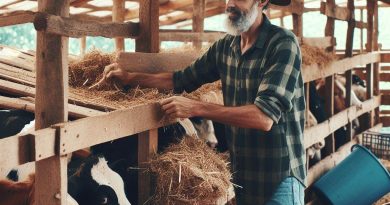Llama & Alpaca Breeding: Genetic Tips
Last Updated on March 2, 2024
Introduction
Let’s explore Llama and Alpaca Breeding Genetic Tips.
Understanding genetics is crucial for successful llama and alpaca breeding, impacting traits and herd health.
From color variations to fiber quality, genetic factors influence various traits in llamas and alpacas.
Maintaining diverse gene pools ensures resilience in herds, reducing the risk of genetic disorders and promoting overall health.
Effective breeding involves balancing desirable traits like fiber quality, color, and conformation for optimal herd outcomes.
Responsible breeding practices involve informed genetic decisions to enhance herd characteristics without compromising animal welfare.
Understanding the genetic intricacies of llama and alpaca breeding is the foundation for successful and ethical herd management.
Understanding Llama and Alpaca Genetics
Breeding llamas and alpacas involves understanding their genetics and the importance of genetic diversity.
By comprehending the basics of inheritance patterns and the role of chromosomes and DNA, breeders can make informed decisions to improve their herds.
A. The basics of llama and alpaca genetics
Inheritance patterns play a crucial role in llama and alpaca breeding.
Genes, the units of heredity, are inherited from parents and can be either dominant or recessive.
Understanding these patterns helps breeders predict the traits that offspring may possess.
For example, if a dominant gene for a desirable trait is present, there is a higher chance that the offspring will exhibit that trait.
Chromosomes and DNA form the genetic blueprint of llamas and alpacas.
Genetic information is contained within chromosomes, and these chromosomes are made up of DNA strands.
DNA carries the instructions for the development and functioning of these animals.
By studying the genetic makeup, breeders can gain insights into the potential traits and characteristics of the offspring.
B. The significance of genetic diversity
Genetic diversity is crucial for the health and vitality of llama and alpaca populations.
A diverse gene pool reduces the risk of inherited genetic disorders, as harmful recessive genes are less likely to be expressed.
Inbreeding, which limits genetic diversity, can lead to weakened immune systems and increased susceptibility to diseases.
By maintaining genetic diversity, breeders can ensure the overall well-being of their herds.
Furthermore, genetic diversity enhances the potential for desirable traits in llamas and alpacas.
An abundant variety of genetic traits allows breeders to select for specific characteristics, such as fiber quality or color patterns.
With a diverse gene pool, breeders have more options to improve the quality and desirability of their animals.
This diversity also enables breeders to adapt their herds to changing market preferences or environmental conditions.
Therefore, a solid understanding of llama and alpaca genetics is essential for successful breeding practices.
Breeders should be aware of inheritance patterns and the impact of chromosomes and DNA on the traits of these animals.
Maintaining genetic diversity is crucial for the overall health and vitality of the herds, as well as for enhancing desirable traits.
By applying genetic knowledge, breeders can make informed decisions to improve their llamas’ and alpacas’ genetic makeup and overall quality.
Read: Poultry Genetics: Raising Superior Chickens
Selecting Breeding Stock
A. Importance of evaluating traits in potential breeding animals
- Genetic Foundation: Evaluating traits ensures a solid genetic foundation, influencing the overall health and characteristics of future generations.
- Optimal Herd Outcomes: Selecting animals with desirable traits enhances the likelihood of optimal herd outcomes, from conformation to fiber quality.
- Disease Resistance: Trait assessment aids in identifying animals with inherent disease resistance, contributing to herd health and minimizing veterinary interventions.
- Conformation and Structure: Assessing conformation and structural traits is vital for breeding animals that exhibit sound physical attributes, promoting longevity and functionality.
- Fiber Quality Improvement: By evaluating traits related to fiber, breeders can actively contribute to improving the overall quality of the herd’s fiber production.
- Adaptation to Environment: Traits linked to adaptation and resilience are critical, ensuring that breeding animals can thrive in their specific environmental conditions.
- Temperament and Behavior: Evaluating traits related to temperament and behavior contributes to creating a herd with manageable and cooperative animals.
- Ethical Breeding Practices: Rigorous trait evaluation aligns with ethical breeding practices, emphasizing responsible stewardship and consideration for the well-being of the animals.
In summary, the meticulous evaluation of traits in potential breeding animals lays the foundation for a successful and sustainable llama and alpaca breeding program.
B. Strategies for selecting high-quality breeding stock
- Evaluate Fiber Quality: Examine the fiber characteristics, ensuring it meets the desired standards for softness, length, and color.
- Assess Conformation: Study the body structure, checking for proper proportions, strong bone structure, and overall sound conformation.
- Consider Temperament Traits: Choose animals with calm and manageable temperaments, as these traits contribute to ease in handling and management.
- Review Genetic History: Investigate the genetic lineage, focusing on the health, reproductive history, and performance traits of potential breeding stock.
- Opt for Genetic Diversity: Aim for diverse gene pools to prevent inbreeding and promote overall herd resilience and adaptability.
Selecting high-quality breeding stock involves a comprehensive assessment of fiber quality, conformation, temperament, genetic history, and diversity.
C. The need to establish clear breeding goals
To succeed in llama and alpaca breeding, it’s essential to:
- Define Purpose: Clearly state whether breeding for fiber quality, color, or specific traits.
- Prioritize Traits: Identify traits that align with herd improvement goals, emphasizing their importance in breeding decisions.
- Consider Health and Welfare: Prioritize the overall well-being of animals, ensuring genetic selections contribute to healthy and resilient herds.
- Avoid Overemphasis: While focusing on specific traits, prevent overemphasis on a single characteristic to maintain overall genetic diversity.
- Regularly Review Goals: Breeding goals should evolve as herd dynamics change, necessitating regular reviews and adjustments.
Establishing precise breeding goals ensures a purposeful and ethical approach to llama and alpaca breeding practices.
By following these selective breeding practices, llama and alpaca breeders can significantly improve their herds.
Remember, the breeding stock serves as the foundation for achieving breeding goals and maintaining the breed’s quality.
Take the time to evaluate potential breeding animals before making any decisions, as this will have a long-lasting impact on future generations.
Read: Dairy Cattle Feeding: Best Practices Guide
Breeding Techniques for Genetic Improvement
A. Introduction to various breeding techniques
- Natural breeding: Traditional method that involves mating llamas and alpacas naturally.
- Artificial insemination: Breeding technique where semen is collected and manually inserted into the female.
- Embryo transfer: Process of harvesting and transferring embryos from a donor female to a recipient female.
B. The pros and cons of each technique
Natural breeding, while simple and cost-effective, lacks control over genetic outcomes and may result in inbreeding.
Artificial insemination offers breeders wider access to superior genetics and diminishes the risks of injury during mating.
However, this technique requires specialized equipment and expertise, and success rates may vary.
Embryo transfer enables breeders to produce more offspring from genetically superior females.
Despite its high success rates, this technique is expensive and demands advanced technical skills and facilities.
C. The importance of genetic diversity in breeding programs
Genetic diversity plays a vital role in establishing and maintaining healthy llama and alpaca populations.
It allows animals to adapt to environmental changes and reduces the risk of inherited diseases.
Breeding programs that prioritize genetic diversity enhance the overall vigor and resilience of the herd.
By selectively breeding individuals with different genetic traits, breeders can improve desirable traits and minimize undesirable ones.
This can lead to increased resistance to diseases, better fiber quality, and more efficient food conversion.
Without genetic diversity, the population becomes vulnerable to inbreeding depression and reduced reproductive fitness.
Therefore, breeders must carefully monitor and manage the genetic diversity within their herds to ensure their long-term success.
Generally, various breeding techniques such as natural breeding, artificial insemination, and embryo transfer offer different advantages and disadvantages.
While natural breeding is simple and cost-effective, it lacks control over genetic outcomes.
Artificial insemination provides access to superior genetics but requires specialized equipment and expertise.
Embryo transfer allows breeders to produce more offspring from genetically superior females but is expensive and technically demanding.
Breeders should prioritize genetic diversity in their breeding programs to enhance overall herd vigor and resilience.
By carefully managing genetic diversity, breeders can improve desirable traits and minimize the risk of inbreeding depression and diseases.
Ultimately, genetic improvement is crucial for the long-term success and sustainability of llama and alpaca breeding programs.
Read: 5 Key Trends in Modern Cattle Management

Genetic Disorders and Health Considerations
A. Identify common genetic disorders in llamas and alpacas
- Be aware of common genetic disorders such as congenital cataracts and hypomyelination.
- Understand the implications these disorders can have on the overall health of the animals.
- Recognize the impact they may have on the quality of the offspring.
B. The significance of pre-breeding health checks
1. Genetic testing for carriers of genetic disorders
- Conduct genetic testing to identify carriers of genetic disorder.
- This helps prevent passing on undesirable traits to future generations.
- Eliminate potential health risks and improve the overall quality of the breeding program.
2. Ensuring overall health and fertility of breeding animals
- Conduct thorough health checks before breeding.
- Ensure that the animals are in optimal physical condition and free from any underlying health issues.
- This helps improve the chances of successful breeding and healthy offspring.
C. Tips for minimizing the risk of inherited disorders through careful breeding practices
- Select breeding animals with healthy genetic backgrounds.
- Research and understand the genetic history of potential breeding candidates.
- Avoid breeding animals that have a history of genetic disorders or are carriers of undesirable traits.
- Implement a controlled breeding program to minimize the risk of passing on genetic disorders.
- Consider outcrossing or crossbreeding to diversify the gene pool and reduce the chance of inherited disorders.
- Work closely with a veterinarian or geneticist to ensure the best possible breeding decisions are made.
- Regularly monitor the health and well-being of breeding animals to minimize the risk of complications or genetic disorders.
- Keep detailed records of mating and offspring to track any potential genetic problems.
Overall, it is crucial to prioritize the health and genetic well-being of llamas and alpacas in a breeding program.
By identifying common genetic disorders, performing pre-breeding health checks, and adopting careful breeding practices, breeders can significantly minimize the risk of inherited disorders and promote the overall health and success of their herds.
Read: Essential Pig Nutrition for Growth
Discover More: Top Breeds for Profitable Pig Farming
Record Keeping and Breeding Management
A. Maintaining Accurate Breeding Records
It cannot be stressed enough how important it is to maintain accurate breeding records.
Keeping detailed records of all breeding activities contributes to successful breeding management.
By documenting dates, times, and mating pairs, breeders can track breeding outcomes and identify any issues or trends that arise.
B. The Role of Pedigree Analysis in Tracking Genetic Traits
Pedigree analysis plays a crucial role in tracking genetic traits in llama and alpaca breeding.
Examining the lineage of animals involved in the breeding process helps breeders identify desirable traits and evaluate genetic strengths and weaknesses.
By understanding the pedigree, breeders can make informed decisions about mating pairs to achieve specific breeding goals.
C. Tips for Effective Breeding Management
1. Timed Breeding and Reproductive Evaluations
Utilizing timed breeding and reproductive evaluations can enhance breeding management.
Breeders can synchronize the estrous cycles of female llamas and alpacas to increase the chances of successful breeding.
Reproductive evaluations, including ultrasound examinations, can provide valuable insights into the reproductive health of females and help breeders determine optimal breeding times.
2. Monitoring Pregnancy and Birthing Complications
Close monitoring of pregnancy and birthing complications is essential for successful breeding management.
Regular veterinary checks during the gestation period allow breeders to detect any health issues or potential complications early on.
Additionally, maintaining a clean and comfortable birthing environment and being prepared for emergencies can help ensure smooth and safe deliveries.
Accurate record keeping and effective breeding management are vital for successful llama and alpaca breeding.
Breeders must maintain meticulous records of breeding activities, analyze pedigrees to track genetic traits, and implement strategies such as timed breeding and reproductive evaluations.
Additionally, monitoring pregnancies and being prepared for birthing complications contribute to overall breeding success.
Conclusion
A. Genetic Tips’ Significance
- Precision matters in llama and alpaca breeding.
- Strong genetic foundations ensure desirable traits.
- Optimal health and wool quality result from careful pairing.
- Diligent selection enhances overall herd resilience.
B. Apply Genetic Wisdom
- Embrace selective breeding practices.
- Prioritize diversity for long-term vitality.
- Monitor lineage and hereditary patterns.
- Implement strategic mating for desired outcomes.
C. Closing Call to Action
- Breeding excellence is an ongoing commitment.
- Apply newfound genetic insights.
- Elevate your herd with precision breeding.
- Share knowledge within the community.
In the end, master the art of genetic selection for thriving llama and alpaca herds.
Act now, breed responsibly, and foster a future of resilient and extraordinary camelids.


